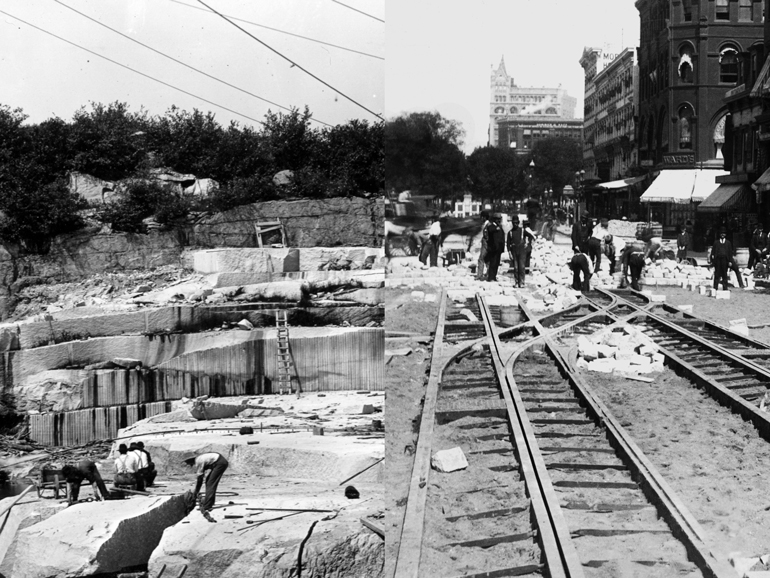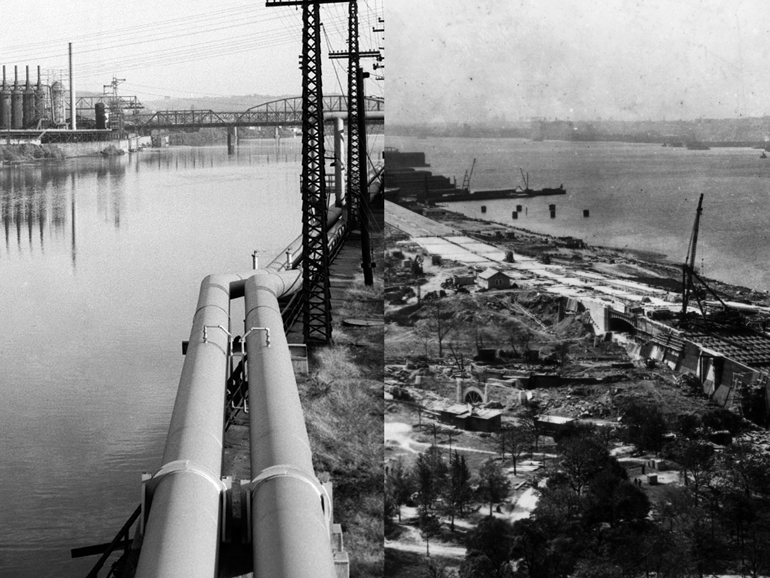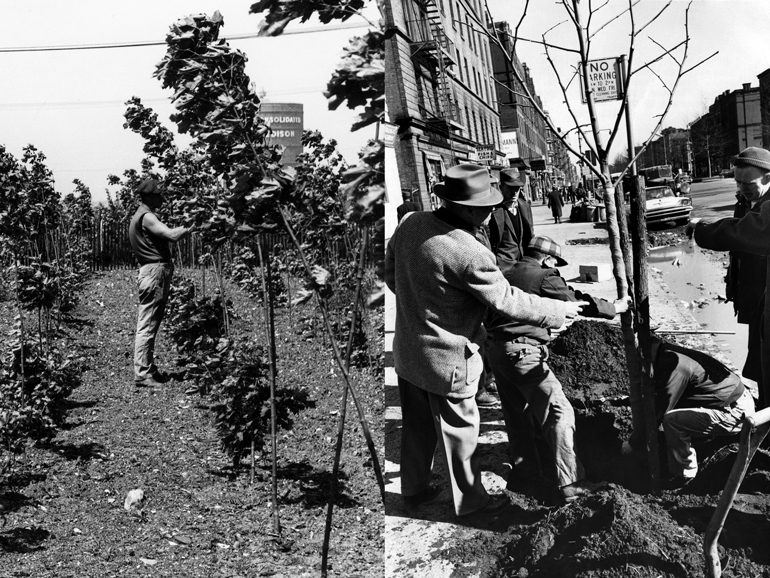
We are celebrating 15 years — and counting — of stories that are deeply researched and deeply felt, that build a historical record of what the city has been.
We are celebrating 15 years — and counting — of stories that are deeply researched and deeply felt, that build a historical record of what the city has been.
Iconic landscapes emerge through visual narratives of before and after. Central Park was groomed from rocky periphery to scene of pastoral recreation; the High Line metamorphosed from weeds growing on rust to tourist destination. But what if we look beyond the site at the broader story of a landscape’s composition? New York City’s parks and promenades are constructed from things — fertilizer, pavers, and planks — sourced from other landscapes. The materials specified in one design reshape other, distant realms in ways that are rarely acknowledged. In the diptychs that follow, drawn from her book Reciprocal Landscapes: Stories of Material Movements, Jane Hutton traces the material flows that have fed Manhattan’s most iconic landscapes. Familiar public spaces appear alongside their secret sharers in Peru’s Chincha Islands, the Pittsburgh waterfront, the Amazon rainforest. Instead of the “before and after” we’re so used to seeing, these paired landscapes are sites of simultaneous development with uneven consequences.
Landscape construction materials are fragments of other landscapes. Not simply fungible commodities, materials are the livelihoods and habitats of people and other species that live with them. They connect the most tactile aspects of urban design to the global circulation of matter. Not static things, materials change shape, value, and meaning as they move through landscapes, hands, and tools, from extraction to use, to demolition, reuse, or abandonment. Tracing the flows of materials that ended up in iconic Manhattan public landscapes, we can visualize the invisible and faraway landscapes that are linked to the familiar ones. We can see how construction in one place alters another: the socially and ecologically unequal exchanges that underpin construction. These paired images show a series of landscapes between which materials have moved. On the left of each pair is the material’s origin, the geological deposit, factory, or extraction site; on the right is the Manhattan public landscape in which it was notably installed. What if we looked at materials not simply as single-purpose products or commodities, but instead as continually changing matter that takes different forms, and is shaped by — but also shapes — others? How might understanding these so-called externalities of development inflect new forms of material practice in solidarity with people, other species, and landscapes elsewhere?
As powerful urbanizing centers like New York City expanded in the mid-19th century, nearby farms industrialized. Instead of fertilizing their fields with local manures only, they shifted to higher-potency, purchased fertilizers. To enrich the lawns of Central Park — designed as a microcosm of an agricultural landscape — landscape architect Frederick Law Olmsted experimented with a range of composted manures and new fertilizer products. Guano (dried seabird excrement), applied in trace quantities, was potent, exotic, and imported from the Chincha Islands in Peru. A thousand-year accumulation of an extremely vital ecosystem, the islands’ guano was extracted in a few short decades. While the global trade in mineral fertilizers supercharged agricultural fields in North American and European centers, guano landscapes were quickly depleted. Enslaved Chinese workers, hired under false pretenses, did this work and died there in horrific conditions. As Britain and the United States (among other countries) drew the fertilizer from Peru to improve soil exhausted by unsustainable agricultural practices, the global metabolic rift — the disconnection between humans and their local natural cycles — multiplied. Industrializing cities were powered by crops and nutrients stolen from colonial and imperially controlled land, never to be returned. In the quest to recharge depleted soils in one place, ecological deposits and humans were exploited and exhausted in another.
Cities along the Atlantic seaboard grew rapidly in the late 19th century: Extensive street grids were paved, or repaved, and large institutional buildings, bridges, and monuments constructed. Granite, hard and noble, was a material of choice. As New York City became a global financial center, crowded streets and broken pavements interfered with the smooth flow of capital and goods. Throughout the city, an uneven patchwork of wood, macadam, and stone held stagnant water, mud, and refuse — and Broadway was particularly uneven and jammed up. Large government contracts for granite paving blocks bolstered New England quarry operations and drew granite cutters to small towns like Vinalhaven in the Fox Islands of Maine. As the islands’ quarries deepened and New York City’s streets hardened, quarry owners profited at the expense of precariously employed and poorly compensated workers. In response, Maine quarry workers organized the country’s first stonecutting union. In 1892, the heavy flow of granite from Maine to New York was disrupted as paving workers in New York City went on strike in solidarity with locked-out Maine workers. Material flows might appear to be abstract vectors, but they are carried by human hands, and can be powerfully disrupted by them.
Granite gave way to concrete reinforced with steel for the city to grow taller. In the 1930s, progressive New Deal legislation funded massive, steel-intensive public works including the renovation of Riverside Park along the Hudson River. There, open-air rail tracks were covered in steel and parkland, transforming the industrial riverfront into a seamless landscape privileging leisure and mobility. At the same time steelmaking transformed the Monongahela River surrounding Pittsburgh. Blast furnaces and steel mills processed ore from Minnesota and coal and limestone from southern Pennsylvania, and shipped structural steel to cities like New York City where towers and infrastructure were multiplying. The Pittsburgh mills deposited slag into new landforms, sent waste downriver, and thick smoke into the air. Progressive policies radically reshaped the public sphere — and they did so in steel. In Pittsburgh, New Deal labor legislation offered critical support for steel workers’ struggles towards collective bargaining and greater union power. In Riverside Park, this occurred as people went back to work under emergency relief programs, constructing scores of public works while developing new public modern landscapes.
By the late 1950s, the widespread erosion of social programs and stable factory work, and ongoing racial segregation manifested in a decaying public realm that extended to New York City’s decaying street tree canopy. Communities of color had long fought for decent municipal services, housing justice, healthcare provision, and community amenities — including the improvement of the streetscape with trees. One group in Harlem, the People’s Civic and Welfare Association (PCWA), linked the struggle for basic civil rights with the right to a clean, safe, and healthy street. On a spring day in 1959, in response to the PCWA’s 13-year-long request, the city installed the first of 398 London Plane trees that would run up Seventh Avenue from 117th Street. These London plane trees (Platanus x acerifolia) grew in a Parks Department tree nursery not far away on Rikers Island. Over decades, this nursery provided a cheap and continuous supply of tens of thousands of trees for streets and municipal parks, with the unpaid (and later barely paid) work of incarcerated people. Cities bear many heroic individual development myths, but the voluminous tree canopy (and its invisible, undocumented, and uncompensated makers) serves as a reminder that a city really is a collective construction. Trees have stood as both an indicator of the health or illness in the urban environment, and now are more clearly understood as a partner in survival — in part because they need so much care.
As manufacturing and industry migrated out of Manhattan in the later 20th century, industrial infrastructures were taken down — or as in the case of Chelsea’s elevated rail structure, adapted to new recreational uses. A well-loved park, The High Line is lauded for its creative reappropriation of an otherwise obsolete structure, providing an important precedent for reuse instead of demolition. The walkways of the first phase of the High Line were decked with ipe (Tabebuia spp.), an extremely hard and decay-resistant tropical hardwood that has become one of the most prized woods for outdoor applications. The use of durable materials is a central tenet of sustainable building best practices: High-quality materials last longer, they don’t need to be replaced as soon. Ipe’s slow growth and natural defenses produce the physical properties that it is admired for. But because the harvest of ipe (from the Amazon forest in Brazil and Peru) targets sparsely distributed, old-growth trees, and participates in patterns of large-scale deforestation driven by global markets, its use is controversial. A later phase of the High Line incorporated salvaged lumber, and the Parks Department has pivoted away from tropical hardwood procurement. In ipe on the High Line, we see various intertwined processes of globalized capitalism: the shifting of industry elsewhere, the increased access to global lumber, and the outsourcing of ecological risk.
The views expressed here are those of the authors only and do not reflect the position of The Architectural League of New York.



